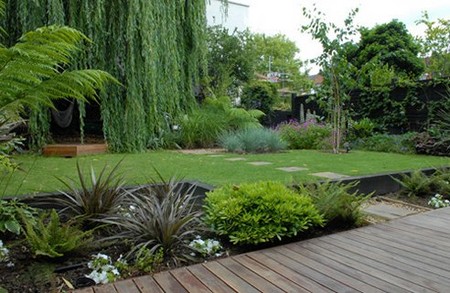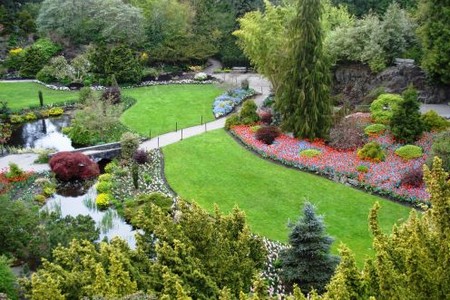Best Way to Design a Low-Maintenance Garden
The focus of this simple design is a relatively clear area in the centre of the garden, and there are two main features of interest, the circular seat and the raised pool. Everything has been chosen to last and to stay looking good with minimum maintenance. The brick wall at the rear of the garden, for example, is well built and will be maintenance free for many years. The design is deliberately restrained because a simple design is easier to maintain than a more complex layout covering the same area, and the simplicity of the overall scheme adds to the attraction of this garden.
The square shape of the garden has been broken up by the use of asymmetrical beds, which incorporate curves and straight lines to make the boundaries interesting and exciting. The central area is paved, because this is far easier to maintain than a lawn, and it has been left deliberately uncluttered to make the area seem larger than it actually is. A small entrance to allow access to the garden from the steps is also kept clear, but otherwise planting completely surrounds this garden to create a secluded, intimate space.
The changes in level and texture and the working contrasts between the hard landscaping and the planting make this garden feel harmonious and welcoming, the ideal place to come home to and relax.
Features
The raised beds around the edges and the raised pool introduce valuable changes in height, which also serve to emphasize the central paved area. A narrow bed against the end wall unites the two sides of the garden and softens the wall. The circular tree seat in the shade of the Ailanthus altissima (tree of heaven) and the curved edge of the pool complement and contrast with the uniform square paving.
In the centre of the paved area a square has been marked out using a mixture of bricks, cobbles and small slabs to create an interesting and effective ornamental pattern that will be kept clear with just the occasional sweep with a broom. Different patterns and combinations of materials – wood, brick, pebbles and gravel — could be used to create an individual pattern. This detail and the white-painted cast iron furniture in the middle of the garden, which matches the seat under the tree, draw the eye away from the boundaries and help keep attention within the garden.
The pool adds a contrast in texture and allows a greater range of plants to be grown. The smooth surface of the water reflects the foliage of the plants behind it, and additional interest is provided by the aquatics themselves, which are grown in containers in the water to prevent them from spreading into the pool and to minimize the maintenance required. The area at the rear of the pool is covered in creeping foliage to give the illusion that the pool disappears into the greenery behind. An alternative to the pool would be a raised bed, filled with colourful annuals, which would make a strong statement like the pool but would require more attention to keep the plants in good condition.
Planting
Plants have been chosen that have long seasons of interest. Some produce flowers, some bear berries, and some have autumn colours and even coloured barks in winter. In one corner is an unusual fern, Washingtonia filifera (desert fan palm), which will be a real focal plant and talking point, and on the opposite wall it is balanced by the smaller, but hardier, Osmunda regalis (royal fern).
Shrubs are used in the corners and larger beds to keep maintenance to a minimum, because once they are established they will largely take care of themselves. They create a deep, lush backdrop and a strong green backbone to the rest of the planting. Plants with strong forms, such as Cordylinefruticosa ‘Baby Ti’, are included among the softer elements of the planting to add contrast of shape and texture.
Climbers, including the fragrant Jasminum officinale (jasmine), grow up and along the trellis to create a light but well-defined division and provide privacy. The white bricks of the house wall reflect light into the garden and act as an effective foil to the climbing plants and wall shrubs.
Containers are used on the steps to bring the planting nearer the house. These are filled with seasonal or evergreen trailing plants. Using containers that are attractive and in complementary colours means that the garden will still have interest while the plants are dormant.
The perimeter beds vary in depth, providing great scope for a range of plants. An ingenious touch in this garden is that planting is through a porous mulching fabric, which is secured to the soil with staples of heavy-gauge fencing wire. This fabric is concealed with a mulch of bark. Many of the plants are slow growing once they have reached maturity, and this is a simple way to reduce the amount of pruning and dividing that will be needed. An irrigation system, built into the border when it is initially planted, will save time and lead to better plant growth so that the garden will mature sooner than might otherwise be expected, and annual mulching will help both to retain moisture in the soil and keep down weeds.
Categories
Advertisements
Recent Articles
 How to Understand Bed Sizes – A Small Guide
How to Understand Bed Sizes – A Small Guide How to Select Some Must Have Kitchen Accessories
How to Select Some Must Have Kitchen Accessories Best Way to Change a Car Tire
Best Way to Change a Car Tire Best Way to Write an Affirmation
Best Way to Write an Affirmation Best Way to Take Charge of Your Financial Life
Best Way to Take Charge of Your Financial Life Best Way to Survive a Party When You Don’t Know Anyone
Best Way to Survive a Party When You Don’t Know Anyone Best Way to Stop Self Sabotaging Yourself
Best Way to Stop Self Sabotaging Yourself Best Way to Start Journal Writing
Best Way to Start Journal Writing Best Way to Speak with a Powerful Voice
Best Way to Speak with a Powerful Voice Best Way to Simplify Your Life
Best Way to Simplify Your Life Best Way to Respond to a Put-Down
Best Way to Respond to a Put-Down Best Way to Reduce Acne Breakouts
Best Way to Reduce Acne Breakouts Best Way to Recover from Dining Disasters
Best Way to Recover from Dining Disasters Best Way to Quit Your Job Gracefully
Best Way to Quit Your Job Gracefully Best Way to Make Your Own Website
Best Way to Make Your Own Website



Leave a Reply